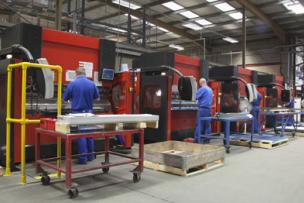Using the Six Big Losses approach is a practical way to identify production inefficiencies as they relate to equipment-based flaws in your production workflow, directly harming the bottom line of your manufacturing business.
Focusing on these six areas can also help you make a more accurate assessment of your production losses, arm you with good data to deal with those losses, and help you increase production time and improve part quality.
The six categories are placed under three main causes for performance losses in OEE: availability losses, performance losses and quality losses. Within those categories, the Six Big Losses are:
Availability losses:
- Equipment failure
- Setup and adjustments
Performance losses:
- Idling and minor stoppages
- Reduced speed
Quality losses:
- Production defects
- Startup defect losses
Here’s a look at each of the six losses, how they can crop up in your day-to-day operations and what you can consider doing to reduce their impact on production.
No. 1: Equipment Failures
These unplanned stops are periods of time in which equipment is scheduled for production but isn’t running due to an unforeseen event, meaning your operation is losing money.
Unexpected production halts, which are largely due to equipment failures or breakdowns, can lead to costly unplanned downtime, making them one of the most critical losses for companies to deal with.
What causes these failures? Operator errors, or poor maintenance of equipment. Other culprits include software or hardware problems.
To manage these issues, make sure you document the downtime periods: when they occur and the reasons for the failure. To mitigate problems, consider adopting predictive and preventive technologies into your equipment.
Read more: Anti-Fog Eye Protection Technology: How MCR Safety’s MAX6 Coating Keeps Workers Safe
No. 2: Setup and Adjustments
These are periods of time when equipment is not running due to a planned event: product changes, necessary minor adjustments to tooling, cleaning, maintenance or quality inspections.
To reduce the negative impact of these periods, make use of the scheduled downtime to do more than one necessary adjustment.
A required period of tool maintenance could also encompass the time to perform a necessary recalibration, equipment cleaning and other maintenance activities. In this way you can shorten the period of time when your equipment is inactive.
No. 3: Idling and Minor Stoppages
These stops typically last for short periods and are due to production errors. They can include material jams, incorrect settings or misfeeds and can usually be resolved quickly by an operator.
These small stops are often recurring issues caused by the same problem. A way to manage them is to encourage operators to notice why these small stops happen in the first place and document them each time.
These records help operators look out for future stoppages caused by these issues and avoid them. Reducing these minor stoppages can help free up time for you to focus on fixing larger issues, such as defective equipment.
Read more: Head, Face and Eye Protection for Your Workers: What to Use and When
No. 4: Reduced Speeds
When equipment runs slower than the ideal cycle time (the fastest possible time to make one unit), you can see a performance loss. This may be caused by such problems as worn-out equipment or poor lubrication.
To reduce the impact of these slower-speed periods, identify recurring problems by documenting them so they are less likely to reappear. Other potential actions to consider may include automating tasks that were previously performed manually to eliminate human-made errors. You may also consider training operators to help them improve cycle time.
No. 5: Production Defects
These defects lead to substandard products that are created during normal production processes. In general, these parts don’t meet quality standards, are damaged or are scrap.
What causes these defects? Errors such as incorrect equipment settings, operator or equipment handling errors, or using substandard materials.
Check each of these inputs to your process frequently as part of your preventive maintenance plan.
Technology can help mitigate these losses, too. Improve operator training and support by, say, creating a video tutorial on how to set up a particular process so an operator can review it before or during a setup. Performing more quality checks during production can also help eliminate defects.
No. 6: Startup Defects
These defective parts are typically produced during your equipment startup period up until stable production is reached. They are also common after changeovers.
To mitigate the issue, consider putting in place data collection systems that track the defects that occur during startup periods and defects that occur during production, as they sometimes require different solutions.
Other potential solutions include implementing a preventive maintenance plan and making sure your operators are following the appropriate procedures for production startups.
Data Collection and Analysis
In essence, the Six Big Losses are a way to identify equipment problems with a level of detail beyond availability, performance and quality losses.
These are losses that are typical of the ones seen regularly by manufacturers—machine wear, misfeeds or operator errors, etc.—and lead to frequent stops and adjustments, which decrease machine performance, and ultimately, your profitability.
Performance losses often go unclassified or unmeasured because of their frequency and variety. But when detail about these losses is captured, measured and analyzed, it can be used to drive improvements and boost your overall manufacturing efficiency.
What steps are you taking to measure your losses and improve equipment performance? Share your thoughts in the comments below.





Talk to Us!
Leave a reply
Your email address will not be published. Required fields are marked *